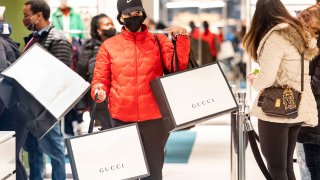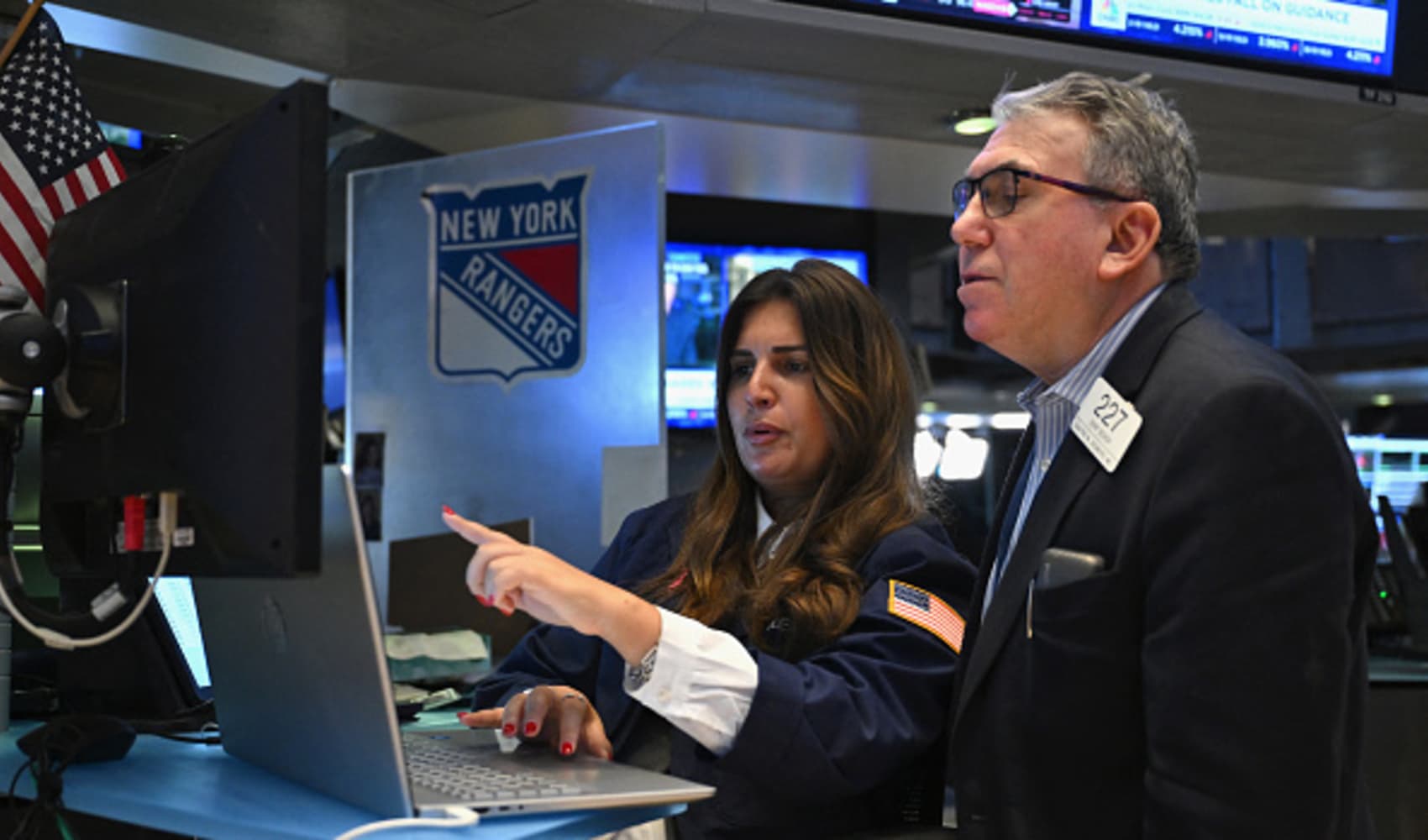
- Chief financial officers at top corporations worry that consumer strength may ultimately force the Fed to raise rates more than it is signaling.
- Demand will remain too high and the central bank lacks the ability to increase supply.
- The Fed's current plans for 50 basis point rate increases may be too little and take far too long to tame inflation, according to members of the CNBC CFO Council.
The outlook from the markets and macroeconomists has been all about the U.S. consumer this year. As inflation has stuck around and the Fed shifted to its hawkish stance, confidence that the economy can withstand the conditions has centered on continued consumer strength.
But what if strong consumer spending, which is still very much the case based on the data, is the final curtain on this period of economic growth rather than another act in the bull market? Consumer demand, and the inability for a throttled supply chain to keep up, could ultimately ensure that the Fed needs to become even more hawkish than it is currently telegraphing to control inflation.
This is the view of chief financial officers who recently took part in a CNBC CFO Council discussion about the central bank, interest rates and economy. CFOs from top companies across sectors of the economy suggested the recent stock market bearishness may be early, but it isn't necessarily misplaced. While the Fed's monetary policy tools can help tamp down demand, the central bank can't do much to get supply to keep up, and its policy plans to date won't be enough to change the global economic equation.
Get South Florida local news, weather forecasts and entertainment stories to your inbox. Sign up for NBC South Florida newsletters.
"I'm confident we are going to get inflation back down to our 2% target," Minneapolis Fed President Neel Kashkari told CNBC on Monday morning. "But I am not yet confident on how much of that burden we're going to have to carry vs. getting help from the supply side," he said.
This, in a nutshell, is the big concern among CFOs.
The outlook on where rates end has shifted up considerably, according to the recent CNBC Fed Survey, with the biggest increase between Fed meetings in over a decade. And CFOs expect more upside risk to rates, which remain far from a sure mechanism to avoid inflation. With inventory problems sustained by consumer demand, and further exacerbated by recent shutdowns in China caused by Covid, and geopolitics, the ability for the supply chain to meet demand may not change.
Money Report
This Wednesday's April CPI, with headline inflation still expected in the 8% range, will be a focus for the debate over peaking inflation.
CFOs on the recent CNBC CFO Council call were of the view that even if the Fed won't talk about a 75-basis point hike right now — Chair Jerome Powell said at last week's FOMC meeting it was not under active consideration — this may prove to be more of a negative than positive in the battle against inflation. The Fed's focus on doing "a few 50s" — 50-basis point rate hikes — is not surprising given that the central bank stresses a data-dependent approach and wants to view the results of its actions into the late summer and early fall. But this leaves concern among CFOs that it will fall short of the mark as a response to the current inflationary environment.
A recession feels inevitable, according to multiple CFOs, with inflation already embedded, and the longer it stays around, the more difficult it becomes to wring it out of the economy. CFOs fear there is more heavy lifting ahead and rates will go higher than the Fed forecast, which has rates reaching 2% to 2.25% by the end of the year and a terminal rate just over 3%.
Companies keep talking about their ability to pass on price increases to customers, but that pricing strength seems to be waning as a source of confidence for the C-suite. There is $2 trillion in excess savings, and to date, consumer spending is not just meeting the inflation level, but exceeding it in terms of real spending data.
Travel is one example of where spending is accelerating. Consumers are "trading up," too, a trend noted by several CFOs, ranging from buying pricier airline seats and premium cars, to going to more expensive restaurants, companies like Procter & Gamble noting their highest-priced items being the most popular, and big-ticket home renovation projects that are at record levels, according to homebuilder data.
While high prices, and gas prices in particular, have led to declining consumer sentiment, the actual numbers among the middle-income households don't suggest much financial stress. For the average 12,500 miles-a-year driver, the increase in gas prices equates to roughly $10 a week, and for middle-income consumers, this won't drive much change in spending behavior.
Recent transactions data shows bigger purchases in travel, furniture, appliances, and electronics, all signs that consumers at the high end are overwhelming those who are actually struggling.
Consumer debt is growing at the fastest rate seen in a long time, up to near-$16 trillion in Q4, according to the New York Fed, and its latest consumer debt data through Q1 2022 released on Tuesday hit a record level. Last month, credit card balances came in at a $52 billion increase, more than double the expectation and the largest month-over-month increase on record.
Wage gain data, meanwhile, has tended to focus on the fact that the rate is still not keeping up with inflation, but in aggregate, the picture looks different: the total amount of wages going to workers is above inflation as the economy put roughly 2 million new people to work this year. This goes back to household balance sheets, which CFOs described as not only good but still having a lot of unused firepower, with more workers coming back into the labor market, in many cases spouses, improving the situation for middle-income households.
But the consumer balance sheet as a recession stopper is not an idea CFOs are willing to embrace in the face of a supply chain which remains under stress. In fact, the idea was referred to as naive. As demand continues to exceed supply in the developed world, the Fed will ultimately need to push harder on the brakes and could take interest rates as high as 5% to knock demand down. That's a recession maker, and if not a severe downturn, not a mild recession either.
It's not just the consumer that is strong now. Business investment and spending remain strong, too.
Concerns about the tech sector, which has led the stock market lower and where private company valuations have been slashed, may be early but again not wrong. An email from Uber's CEO to its staff on Monday outlined a "seismic" change in how investors are viewing the company and the need to focus on free cash flow fast. But the cash balances for private technology companies are at all-time highs because of fundraising they did last year, above where they were in 2019 and 2020, and these firms are continuing to spend without any impact from inflation. This is an area where the data may dampen in the next year. The real-time cash balances of cash-burning companies in tech will become running-low-on-cash balances beyond six to nine months. Credit markets are already starting to tighten in a sign of typical late cycle behavior.
This means deceleration in the market's most important sector, but short of the idea that companies by and large can make decisions on inventory, production, and investment and spending, which head off a recession. The more the market comes to believe a recession is inevitable, there is an argument that businesses can be the ones to let the air out of the bubble slowly — the Fed's "soft landing."
CFOs consulted by CNBC were not betting on this outcome.
Stopping inflation amid the backlogs in the supply chain will be problematic, Covid and war contribute even more to an inventory imbalance that endures, forcing the Fed's hand more than it has been willing to indicate so far.






